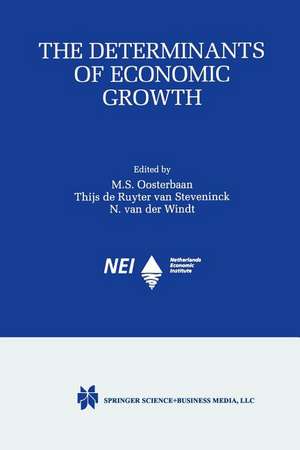The Determinants of Economic Growth
Editat de Maaike S. Oosterbaan, Thijs de Ruyter van Steveninck, Nico van der Windten Limba Engleză Paperback – 3 oct 2012
| Toate formatele și edițiile | Preț | Express |
|---|---|---|
| Paperback (1) | 640.55 lei 6-8 săpt. | |
| Springer Us – 3 oct 2012 | 640.55 lei 6-8 săpt. | |
| Hardback (1) | 646.75 lei 6-8 săpt. | |
| Springer Us – 30 sep 2000 | 646.75 lei 6-8 săpt. |
Preț: 640.55 lei
Preț vechi: 753.60 lei
-15% Nou
Puncte Express: 961
Preț estimativ în valută:
122.58€ • 127.25$ • 102.21£
122.58€ • 127.25$ • 102.21£
Carte tipărită la comandă
Livrare economică 24 martie-07 aprilie
Preluare comenzi: 021 569.72.76
Specificații
ISBN-13: 9781461370208
ISBN-10: 1461370205
Pagini: 300
Ilustrații: XIII, 281 p.
Dimensiuni: 155 x 235 x 16 mm
Greutate: 0.42 kg
Ediția:Softcover reprint of the original 1st ed. 2000
Editura: Springer Us
Colecția Springer
Locul publicării:New York, NY, United States
ISBN-10: 1461370205
Pagini: 300
Ilustrații: XIII, 281 p.
Dimensiuni: 155 x 235 x 16 mm
Greutate: 0.42 kg
Ediția:Softcover reprint of the original 1st ed. 2000
Editura: Springer Us
Colecția Springer
Locul publicării:New York, NY, United States
Public țintă
ResearchCuprins
Introduction: Economic growth and its determinants—An overview.- 1 Recent developments in endogenous growth theory.- 1.1 Framework for the empirical analysis of growth.- 1.2 Empirical findings on growth across countries.- 1.3 Implications of the cross-country findings for advanced countries.- 2 The joys and sorrows of openness: A review essay.- 2.1 The many dimensions of openness.- 2.2 The joys of openness.- 2.3 The sorrows of openness.- 2.4 Conclusions.- 3 Technology in growth.- 3.1 Introduction.- 3.2 Development of the literature.- 3.3 Empirical studies: R&D and the impact of property rights on growth.- 3.4 Conclusions.- 4 Financial markets, financial flows, and economic growth in LDCs.- 4.1 A fiscal foreword.- 4.2 Domestic finance.- 4.3 Foreign debt accumulation.- 4.4 Foreign direct investment.- 4.5 Conclusions.- 5 Institutional development and economic growth.- 5.1 Introduction.- 5.2 What are institutions?.- 5.3 Culture and social equilibria.- 5.4 Extensive and intensive growth.- 5.5 Changing material and cosmological beliefs.- 5.6 The family, the market, and the state.- 5.7 Conclusions.- 6 Human capital and growth: The cost of rent seeking activities.- 6.1 Introduction.- 6.2 Standard formulations of the role of human capital in empirical growth equations.- 6.3 Rent-seeking as an economic activity.- 6.4 The impact of rent-seeking on economic output.- 6.5 Rent-seeking and growth in an endogenous growth model.- 6.6 Empirical assessment: Evaluating human capital devoted to rent-seeking activities.- 6.7 Conclusions.- 7 Recent advances in economic growth: A policy perspective.- 7.1 Introduction.- 7.2 Growth theory: Some basic concepts.- 7.3 Education and human capital.- 7.4 Technology, R&D, and trade.- 7.5 Financial markets and capital flows.- 7.6 Institutions andinequality.- 7.7 Empirical studies.- 7.8 Conclusions.- Epilogue.















